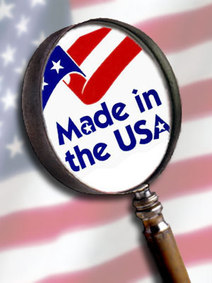
We cannot complain about the lack of jobs in the U.S. when we continue to purchase Chinese and other foreign products. The only way to reverse the trend and bring tax dollars back is to BUY MADE IN USA products.“How do I do that when everything is Chinese?”
Answer: Most individual items DO have Made in USA available; Avoid big box stores, search online, and contact the manufacturer if you are not sure.
“But Made in USA products are too expensive.”
Answer: Not true. While the initial cost may be more (in some cases), over the life of the product it is actually less expensive due to repair and/or replacement costs. It is cheaper to buy quality than quantity. Don’t you remember your parents and grandparents fixing things rather than buying new replacements?
Some Facts:
- Every time you buy a foreign product you are sending a large portion of that money into foreign hands; money that used to stay here and provide good paying jobs and tax revenue for your Local, State, and Federal government. China’s economy is booming while we are in recession.
- Every time you buy a foreign product you are giving the corporation more reason to continue the outsourcing trend
- Every time you buy a foreign product you are eliminating a U.S. job. This job could be your relative or neighbors.
- Every time you buy a foreign product you are lowering your wage. It gives companies and opportunistic politicians the opportunity to call for “streamlining” “lower wages” “lower health-care benefits” “lower taxes for the rich” “lower Social Security” “lower government/the peoples services”
- Every time you buy a foreign product you are probably purchasing an inferior/cheap product that will most likely fail making it a waste of money. You may have to replace the product several times making it more expensive than the American made equivalent.
- Every time you buy a foreign product you could be putting yourself and your children at risk by exposure to lead, cadmium, and other toxic materials. Foreign products DO NOT get tested nor is there any consumer protections for these products.
- Every time you buy a foreign product you are destroying the middle class and their/your neighborhoods. The loss of wages and ultimately their homes provides a decrease in tax revenue and invites rich slumlords to take over once working class areas turning them into neglected slums. Local services such as snow plowing and street paving decline and taxes go up.
- Every time you buy a foreign product you are helping the rich get richer. Fact is that while the ranks of the middle class dwindle, the rich are gaining complete influence and controlling the direction of Federal and State governments. We have no say when these people are in control. We are losing our voice. Money is #1 to certain individuals/entities. Re-gain control and reverse the trend by using your purchasing power and buy/demand products Made in USA!!!
Courtesy of MadeinUSA
Buy Made in USA Products – Yes, it Matters
by MAM TeamAnswer: Most individual items DO have Made in USA available; Avoid big box stores, search online, and contact the manufacturer if you are not sure.
“But Made in USA products are too expensive.”
Answer: Not true. While the initial cost may be more (in some cases), over the life of the product it is actually less expensive due to repair and/or replacement costs. It is cheaper to buy quality than quantity. Don’t you remember your parents and grandparents fixing things rather than buying new replacements?
Some Facts:
Courtesy of MadeinUSA